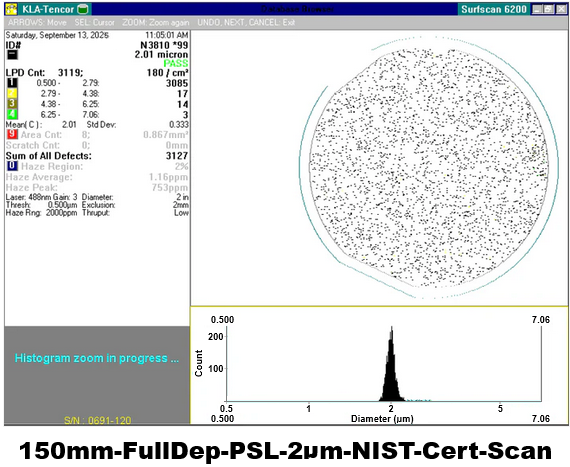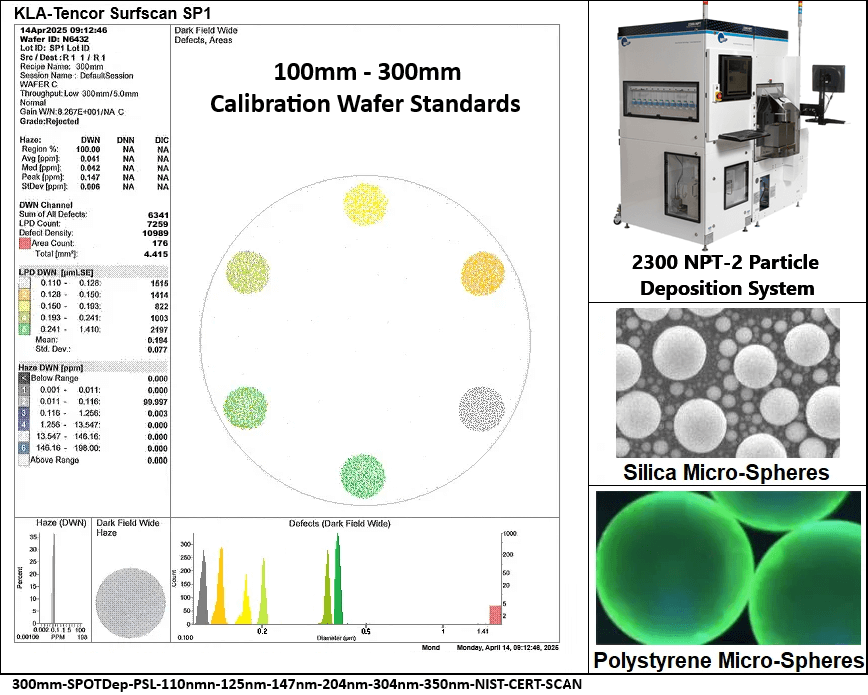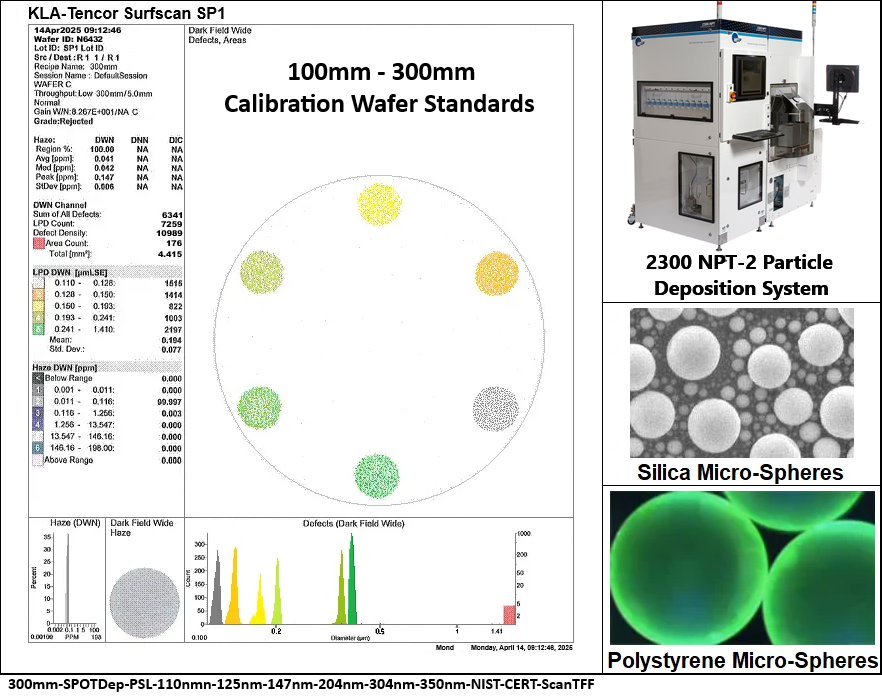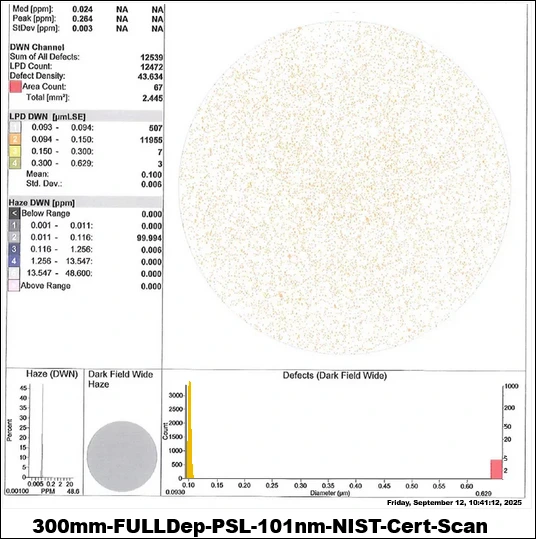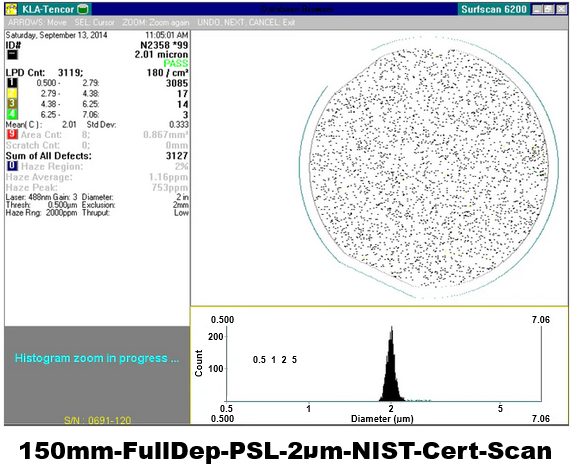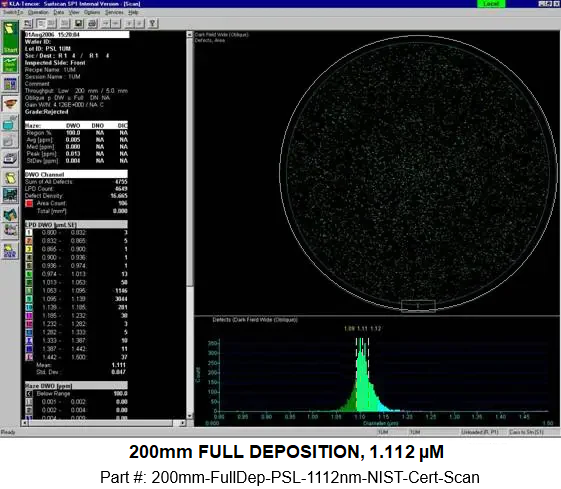Particle and PSL Calibration Wafer Standards | NIST Traceable
Our Calibration Wafer Standards are deposited with polystyrene micro-spheres from 20nm to 12 microns or silica microspheres from 30nm to 1.5 microns. NIST Traceable particle size standards are used to create the exact Particle Wafer Standards needed by Metrology Managers in order to calibrate the size response of Wafer Inspection Systems and Scanning Surface Inspection Systems (SSIS) with highly accurate size standards with narrow size distributions.
Share it :
International Shipment
Your orders are shipped seamlessly between countries
30 Days Warranty
You have the right to return your orders within 30 days.
Secure Payment
Your payments are secure with our private security network.
Description
Calibration Wafer Standards are a fundamental requirement for semiconductor metrology managers and calibration technicians who need to achieve precise, repeatable measurements from Scanning Surface Inspection Systems (SSIS). Your KLA-Tencor Surfscan, Hitachi, or Topcon SSIS tool is only as accurate as its last calibration. Our standards provide the absolute reference point you need to verify size accuracy, test count efficiency, and ensure the uniformity of every scan. Deposited with monodisperse polystyrene latex (PSL) spheres, these standards are the bedrock of a reliable semiconductor metrology program.
Key Specifications & NIST Traceability
Every standard we produce is a testament to precision. We provide a Certificate of Calibration traceable to NIST Standard Reference Materials (SRMs), ensuring that the measurements you take are anchored to internationally recognized standards.
- Particle Material:Monodisperse Silica Microspheres
- Particle Size Range:30nm to 1.5 microns
- Peak Size Distribution:typically ≤ 3% for sizes below 1um
- Available Wafer Sizes:75mm, 100mm, 125mm, 150mm, 200mm, 300mm
- Substrate Compatibility:Prime Silica, Customer Quartz Mask, Customer Film Deposited Wafer
Deposition Methods: Full vs. Spot Deposition vs: Half Deposition
The choice of deposition method directly impacts your calibration application. We offer both full and spot deposition to meet specific operational needs.
Full Deposition
A full deposition standard involves laying down a single particle size across the entire wafer surface, leaving no portion undeposited. This method is ideal for verifying the scan uniformity of your SSIS tool. By challenging the system to detect particles consistently from edge to edge, you can identify and correct for variations in laser intensity or detector sensitivity across the wafer. It’s the most comprehensive way to evaluate the tool’s overall scanning performance. We’ve seen metrology managers use this to diagnose subtle, previously undetected issues in their Surfscan SP5xp tools, ultimately improving their process control.
HALF Deposition
A half deposition standard involves depositing a single particle size on one side of the wafer substrate, so that when scanning the wafer, the scanning system is challenged to detect uniformly on one side of the wafer standards, while also scanning a bare side of the wafer to evaluate how the scanning system detects uniformly on one side with one particle peak, and transitions from the deposited side of the wafer to the bare, clean side of the wafer standard. Half Depositions enable the SSIS tool to be calibrated at a single size, while also evaluating how well the laser scans from a high particle density to a low particle density area to improve particle contamination control.
Spot and Circle Deposition
Spot deposition concentrates PSL spheres in a specific, controlled location on the wafer, creating a visible spot. This technique offers two distinct advantages. First, it allows for the deposition of multiple, distinct particle sizes on a single wafer, making it a highly efficient standard for generating a full size response curve. Second, for contamination monitoring, the defined location provides an immediate reference point, improving count accuracy by eliminating ambiguity about where the tool should be looking. A technician once told me they cut their calibration time in half by switching to a multi-spot wafer for routine checks on their ADE inspection systems.
Advanced Deposition Technology
The quality of a PSL wafer standard is defined by the technology used to deposit the particles. We utilize two primary methods, each with its own strengths.
Direct Deposition
Our direct deposition method involves atomizing a solution containing monodisperse PSL spheres, mixing it with a highly filtered airflow (typically dry nitrogen), and depositing the aerosolized particles directly onto the wafer substrate. This process is highly effective and less expensive, making it an excellent choice for particles in the 1 µm to 12 µm range. It’s particularly well-suited for creating standards used to calibrate tools that monitor for larger contaminants.
Differential Mobility Analyzer (DMA) Controlled Deposition
For the highest level of precision, especially in the sub-micron range (50nm to 1 micron), we employ our Model 2300XP1 Particle Deposition System or 2300NPT Deposition Systems. These systems use DMA (Differential Mobility Analyzer) technology, which functions as a highly sensitive, particle size filter.
The process starts with an aerosol of polydisperse PSL spheres. This aerosol is charge-neutralized, and then passed through the DMA. By applying a precise voltage, the DMA isolates particles of a very specific electrical mobility, which corresponds to a narrow size peak. This technique physically strips away background particles and removes unwanted doublets and triplets (clumped particles) that can skew calibration results. A Condensation Particle Counter (CPC) monitors the count in real-time, allowing for automated recipe control and unmatched particle size deposition accuracy. This is the technology required to create a true 102nm standard with a distribution width under 3%.
Applications and Equipment Compatibility
Our Calibration PSL Wafer Standards are engineered to support the critical functions of semiconductor metrology and are compatible with a wide array of industry-standard inspection tools.
Primary Calibration Functions:
- Size Response Curve Calibration:Establish an accurate size response curve for your SSIS tool.
- Size Accuracy Verification:Routinely verify the measurement accuracy of your inspection system.
- Uniformity of Scan Evaluation:Test the scanning uniformity across the entire wafer surface.
- Count Efficiency Testing:Determine and track the particle count efficiency of your tools.
Compatible Inspection Systems:
- KLA-Tencor:Surfscan SP1, SP2, SP3, SP5, SP5xp, and the 6200, 6220, 6420, 6440 series.
- Hitachi:Full line of SSIS tools.
- ADE & Topcon:Wafer inspection systems.
CRM-CERT-Sample
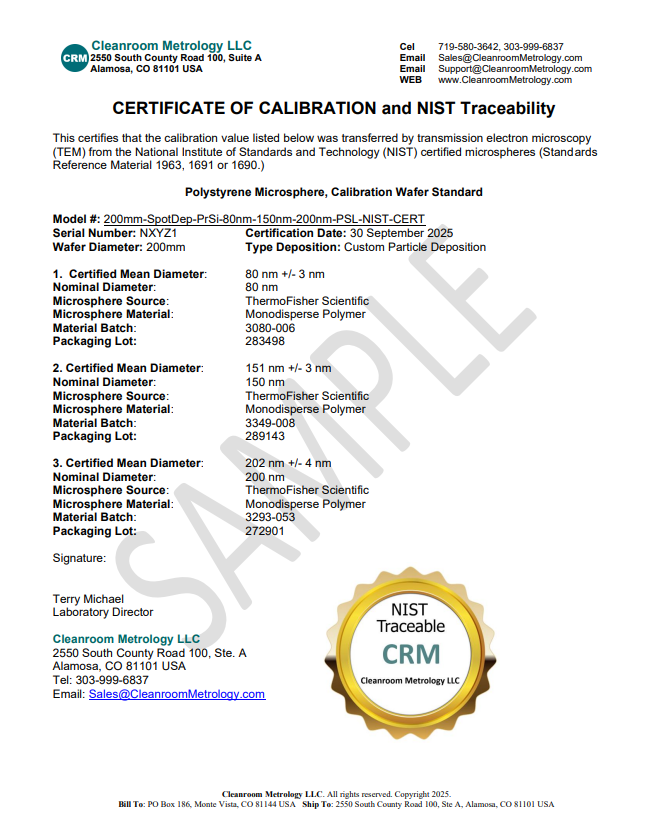
Frequently Asked Questions (FAQ)
What is the standard calibration method?
The standard method involves using a reference material with a known value (our PSL wafer standard) to challenge an instrument. The instrument’s response is then adjusted to match the known value of the standard, ensuring its measurements are accurate.
What are the three types of calibration?
While there are many specific procedures, they generally fall into three types: 1) Comparison Calibration, where an instrument is compared against a more accurate reference standard (this is how PSL standards are used), 2) Discipline Calibration, performed by a specialist in a specific field like dimensional or electrical metrology, and 3) In-situ Calibration, performed on-site without removing the instrument from its operational environment.
What is the 10 to 1 rule of calibration?
This is a metrology guideline suggesting the calibration standard you use should be at least ten times more accurate than the instrument you are calibrating. This ensures that the uncertainty of the standard itself is an insignificant factor in the final measurement. A 4-to-1 ratio is also widely accepted.
What are the 5 requirements for a calibration standard?
A true calibration standard must be: 1) Traceable to a national or international standard (like NIST), 2) Have a known and documented uncertainty, 3) Be stable over time, 4) Have properties relevant to the instrument being calibrated, and 5) Be acompanied by a formal certificate.
What is calibration as per ISO?
As defined by the ISO, calibration is the process of establishing a relationship between the measurements from an instrument and the known values of a reference standard. This operation is done under specified conditions and is used to identify and correct for any deviation in the instrument’s accuracy.
What is the standard for calibration in a lab?
The primary international standard for a calibration laboratory’s competence is ISO/IEC 17025. This standard outlines the technical and quality management requirements a lab must meet to prove it can produce valid and reliable resuts.
What is the difference between ISO 9001 and 17025 calibration?
ISO 9001 is a general quality management standard applicable to any organization. ISO 17025, however, is specific to the technical competence of testing and calibration labs. A lab can be ISO 9001 certified for its processes but must meet the much more rigourous technical requirements of ISO 17025 to be considered a competent calibration authority.
What is the difference between ISO and NIST calibration?
NIST is a U.S. national metrology institute that produces physical standards (SRMs). ISO develops international standards for processes and systems, such as the requirements for a calibration lab (ISO 17025). A calibration is “NIST traceable” if it can be linked back to a NIST SRM through an unbroken chain of comparisons.
What are the ASTM calibration standards?
ASTM International provides thousands of technical standards for specific industries and materials. While ISO/IEC 17025 governs the lab’s competence, an ASTM standard might dictate the exact procedure for calibrating a specific type of instrument, for example, ASTM E797 for calibrating spectrophotometers.
What is the NIST standard for calibration?
NIST (National Institute of Standards and Technology) provides Standard Reference Materials (SRMs) that serve as the physical basis for calibration in the U.S. For particle size, this means using certified materials, like our PSL spheres, whose physical properties have been characterized by NIST to ensure traceability.
What is ISO 17065 standard?
ISO/IEC 17065 is a standard for bodies that certify products, processes, or services. While ISO 17025 applies to the lab performing the calibration, ISO 17065 applies to an organization that would certify that a product, like a PSL Wafer Standard, conforms to its stated specifications.
Additional information
| Weight | 2 kg |
|---|
Scientific Information
Calibration Wafer Standards are also known as PSL Wafer Standards, Particle Wafer Standards and Wafer Calibration Standards. No matter the name reference, the wafer calibration standards are used to calibrate the size accuracy of semiconductor non-pattern, patterned wafer inspection tools and surface scanning inspection systems (SSIS); such as;
Key Applications: Calibrating Wafer Inspection Tools
These standards are essential for calibrating a variety of Surface Scanning Inspection Systems (SSIS), such as:
Tencor 6200, 6220, 6240, 6400
KLA-Tencor SP1, SP2, SPX
TopCon Wafer Inspection Tools
KLA Wafer Inspection Tools
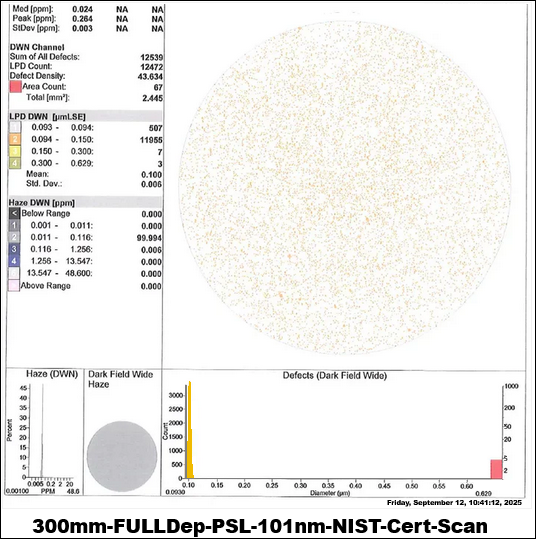
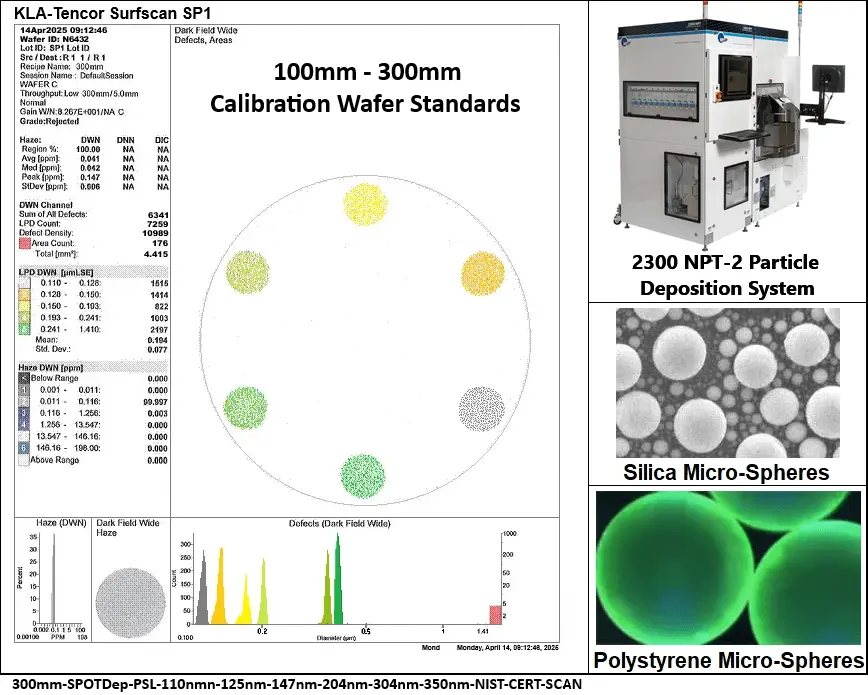
How Are Particle Wafer Standards Produced?
Using NIST Traceable, polystyrene (PSL) particle size standards or silica particle size standards, the spherical particles are deposited on to the substrate of a prime silica wafer surface or a quartz mask surface.
Typical particle deposition is accomplished using a DMA based, particle deposition system, such as a 2300XP1 or 2300NPT-1 or 2300NPT-2. The XP tools are used to deposit on 100mm to 200mm prime silica wafers; while the more advanced 2300NPT tools are used to deposit 200mm and 300mm wafer standards. The 2300NPT tools are more sophisticated with 18nm and above particle deposition capabilities on 200mm and 300mm wafer standards, while the XP tools typically deposit particles from 90nm and above on smaller wafer standards and quartz masks.
Types of Wafer Standard Depositions
Wafer Standards are produced as a FULL Deposition, SPOT Deposition and HALF Deposition, where a FULL DEP wafer has a single particle diameter deposited across the full wafer surface. A HALF DEP Wafer is deposited on one side of the wafer only. A SPOT DEP wafer has from 1 to 10 particle sizes deposited as a SPOT on the surface of a 300mm wafer standard, typically around the outer perimeter of the wafer, but can be deposited at any location on the surface of the wafer, as specified by the customer. Full Deposition Wafer Standards provide 1 particle size for a size calibration point for the wafer inspection system being calibrated. An experienced Metrology Engineer will also view how uniform the wafer inspection system detects the same sized particle, as the inspection system scans the entire surface of the wafer. Half Deposition Wafer Standards provide 1 particle size for a size calibration point of the wafer inspection system, which also allows the Metrology Engineer to see how well the laser of the wafer inspection system responds between the particle clutter on one side of the standard, as opposed to the clean side of the wafer side. e surface of the wafer. Spot Deposition Wafer Standards are generally the most desired wafer standard to challenge the more advanced wafer inspection systems in use today, such as KLA-Tencor SP1, SP2, SPx. A 300mm Spot Deposition wafer standard could have for example 8 size peaks deposited around the wafer, from perhaps 30nm to 2 microns. When an SSIS tool or wafer inspection system scans the 8 sizes during one scan of the wafer standard, the calibration of the wafer inspection system can be evaluated across the full dynamic size response of the wafer inspection and SSIS tool.
Overview of DMA-Based Particle Deposition Systems
We will discuss a manually loaded 2300XP1 and a Fully Automated 2300 NPT-2 Particle Deposition Systems. Both systems are designed around a well-established, scientific method of particle sizing, using a DMA technology (Differential Mobility Analyzer), where a very precise, adjustable air flow velocity and an adjustable voltage is used to isolate a specific particle diameter for an output from the DMA; which is then directed from the DMA to the surface of the substrate being deposited, such as a 100mm to 300mm Prime Silica Wafer, a Quartz Wafer or a Quartz Mask.
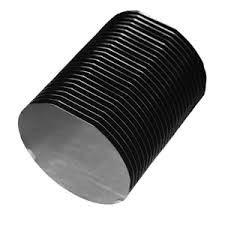


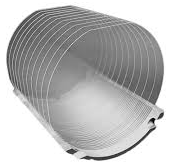
Core Components of a Particle Deposition System
A Particle Deposition System is a sophisticated tool which includes an Atomizer(s) to create an aerosol output, a DMA to select a Particle Diameter output from the aerosol input, a particle counter, typically a Condensation Particle Counter (CPC) and the respective power supplies, control hardware, software and displays used to manage the particle depositions. The input particle stream is typically composed of a desired particle peak and the unwanted particle residue, composed of unwanted nanometer particles below the desired particle diameter peak (often called “haze particles”), as well as larger unwanted particles above the desired particle diameter to be deposited.
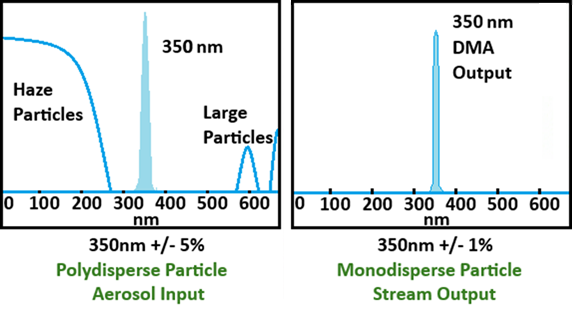
The Function of the Differential Mobility Analyzer (DMA)
The Differential Mobility Analyzer (DMA) is design of elegance in that it is very effective at removing unwanted particles below and above the desired particle diameter output; such that the DMA becomes a very precise particle filtering tool. In the case above, the DMA input is a polydisperse aerosol, which includes a 350nm polystyrene particle peak with a typical +/- 3-5%, distribution, along with the unwanted background Haze Particles and Large particles that are inherent when creating an aerosol mist. The desired output from the DMA is an accurately sized particle peak, based on NIST Traceable size calibration of the DMA, in this example a narrow 350nm polystyrene microsphere distribution stripped of the unwanted background Haze particles and Large particles. The 350nm particle stream is then to be directed onto the surface of a clean substrate, creating a particle wafer standard.
The 2300 XP1 graphics below describes a particle aerosol input to a single Atomizer on the 2300XP1, which includes the desired particle peak along with the unwanted particles within the aerosol input. The DMA is very efficient at isolating a specific particle diameter output from a polydisperse input, showing how the DMA effectively filters the unwanted particle sizes from the desired particle distribution, so that the DMA output is controlled to produce a desired, precisely sized particle diameter with a very narrow particle size distribution width o0n the output of the DMA.
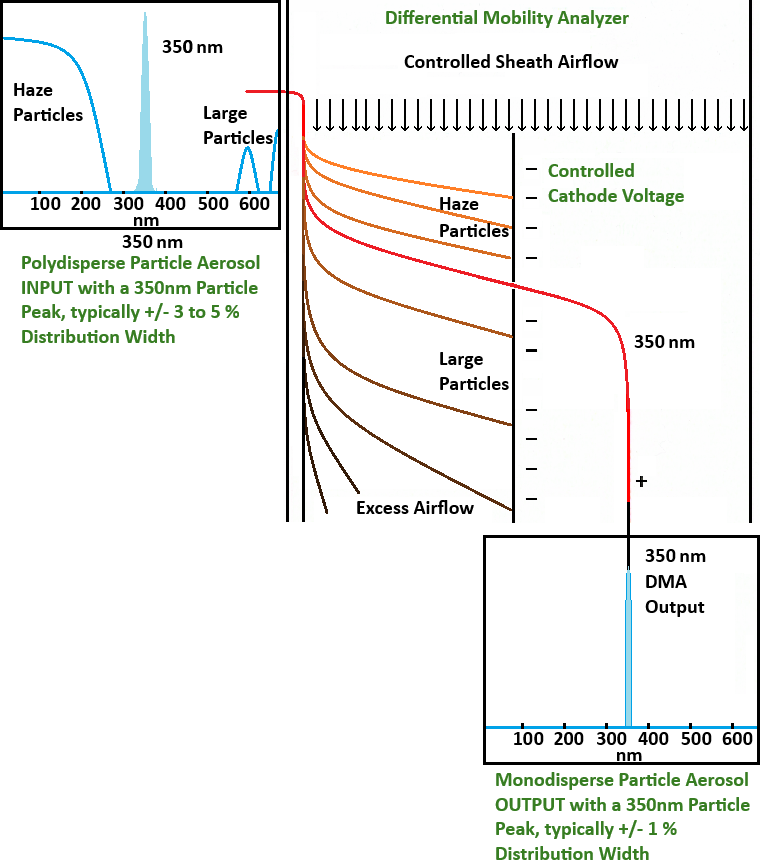
DMA Operating Principles and Calibration
A Sheath Airflow is introduced into the DMA, controlled very precisely for filtered air velocity and electrode voltage. An input particle size aerosol is introduced into the sheath airflow, and as the particle aerosol travels down the DMA at a controlled velocity, the Cathode begins to attract the positively charged particles towards the Cathode. But at a particular voltage and airflow velocity, a specific diameter particle mass is allowed to escape to DMA, that being the particle size desired to be deposited onto a wafer, mask or patterned wafer. At a prescribed spherical particle diameter, each PSL microsphere (or Silica microsphere) has a specific spherical mass at that particle diameter mass. By precisely controlling the input Sheath airflow velocity and the Cathode voltage, a monodisperse particle distribution is allowed to escape through the lower DMA output; thus an exact particle diameter can be extracted from an polydisperse input aerosol, then sampled for count, and finally deposited onto a prime silicon wafer (or mask) surface. A calibration curve can be created for the DMA using NIST Traceable SRMs at 60nm, 101nm, 269nm and 895nm, such that the DMA can be assigned a calibration curve for PSL (polystyrene latex microspheres), as well as silica microspheres, so that the DMA output is calibrated to within a very narrow particle diameter certainty. Both types of spherical particles (polystyrene or silica) are very close in refractive index; thus, both types of particles are very useful for semiconductor metrology calibration of wafer inspection systems, scanning surface inspection systems, etc. Silica and polystyrene have slightly different mass at any specific size, so it is important to have a calibration curve that can be selected for either type of particle mass for accurate particle sizing from the DMA.
The two primary Particle Deposition Systems used in the semiconductor industry today are the 2300XP1, a manually loaded particle deposition system for 100mm to 200mm wafers; while the 2300NPT-2 is an autoload particle deposition system for 200mm and 300mm wafers. The 2300XP1 can deposit from 80nm to 2+ microns on the manually loaded 100mm to 200mm wafers and mask substrates, depositing polystyrene microspheres or silica microspheres. The 2300XP1 uses a single Atomizer to create a single particle aerosol input into the DMA, so depositing multiple particle sizes has a longer handling process to complete a SPOT DEP Calibration Wafer Standard. The 2300NPT-2 is an Autoload Particle Deposition System that deposits polystyrene and silica microspheres from 18nm to 2+ micron particle diameter from a selection of 11 particle atomizers; so combining Autoload and more atomizers, allows the 2300NPT-2 to produce a quantity of very accurate Calibration Wafer Standards. Both Particle Deposition Systems have “Operating Recipes”, which are created as needed and saved to file for future repeatability, and the recipe controls all the deposition dynamics for each particle deposition, providing consistent, accurate particle sizes deposited, and repeatable depositions so that calibration wafer standards produced are very consistent and accurate in particle sizing, today and tomorrow.
2300 NPT-2 Particle Deposition System w/ Automated wafer Handling System and 11 Particle Atomizers
200mm Wafer Cassette or 300mm Wafer FOUP (RoseFinchTech)
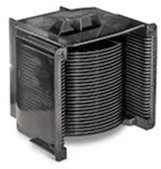
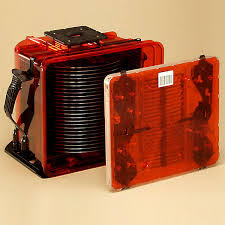
2300NPT-2 Particle Deposition System (viewed from 2 different sides)
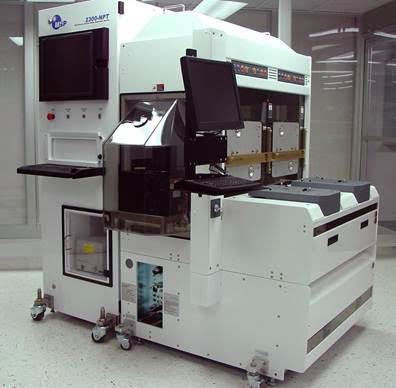
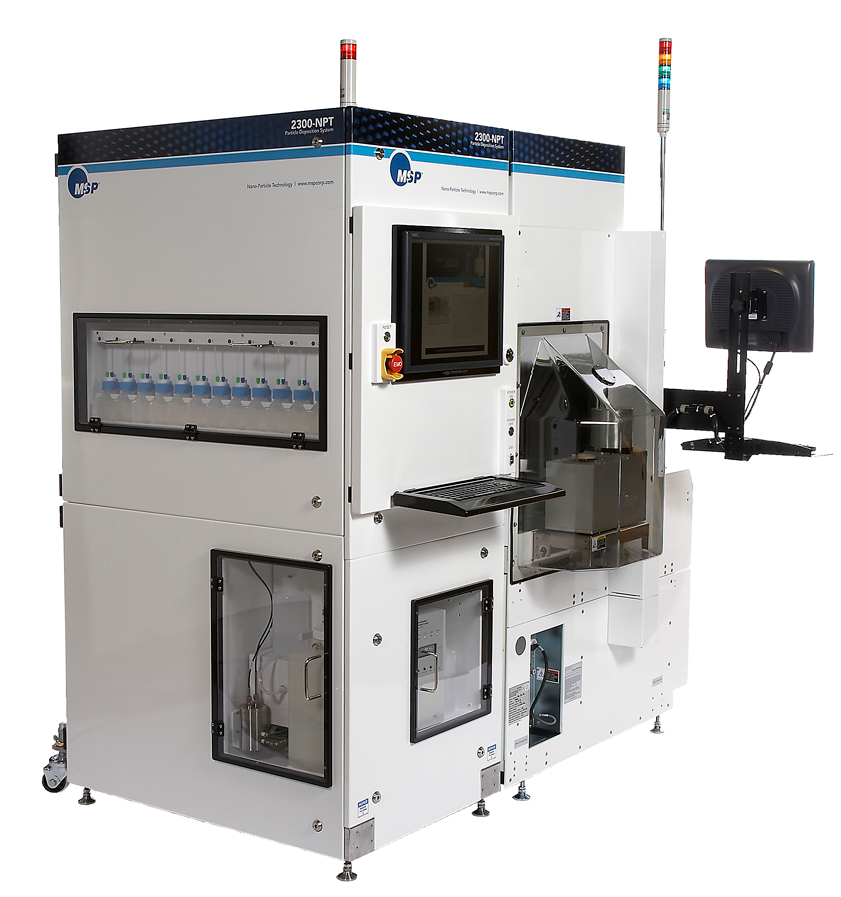
DMA-Differential Mobility Analyzer

Full Deposition Particle Wafer Standard or SPOT Deposition Particle Wafer Standard
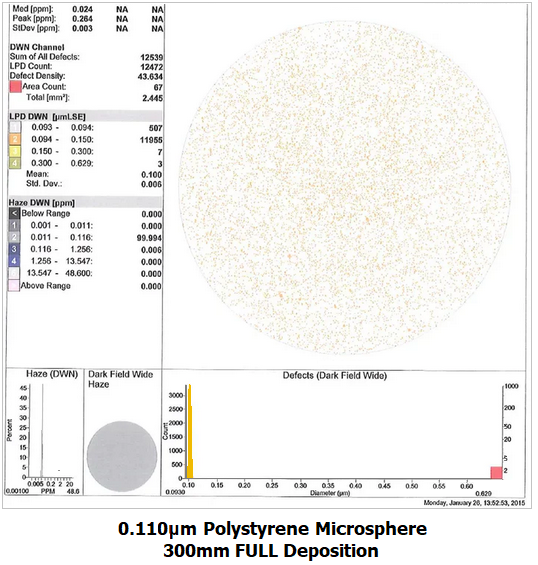
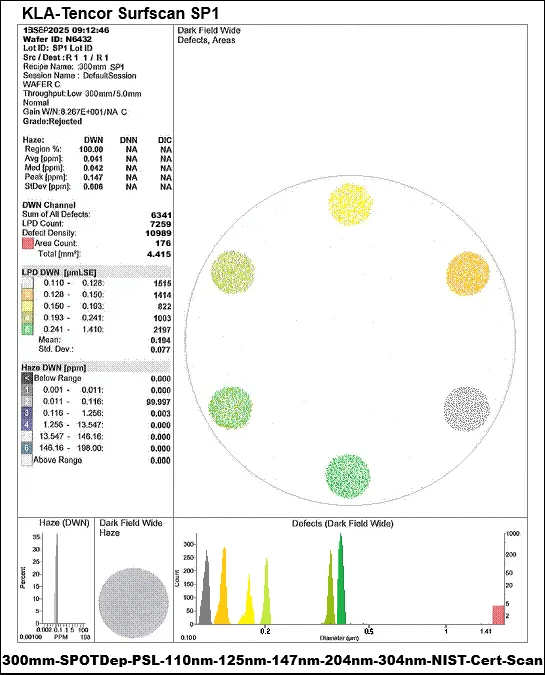
2300 XP1 Particle Deposition System w/ Manually Load Wafer Handling and 1 Particle Atomizer




